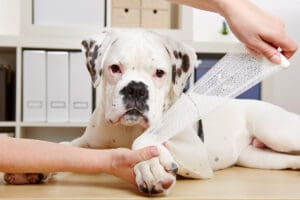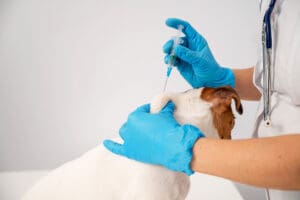Occasionally, our beloved furry companions may face emergency situations that require a quick and effective response. Being prepared to act appropriately in these moments can make the difference between saving your furry friend’s life and facing major complications. In this blog, we will talk about first aid for your furry friend and how to act in every case of emergency:
Heat stress
Heat stroke is a common emergency for furry dogs, especially during the hottest months of the year. Signs of heat stress include excessive panting, difficulty breathing, excessive drooling, lethargy and disorientation. If you suspect your furry friend is suffering from heat stroke, follow these steps:
- Move your furry friend to a cool, shady place immediately.
- Provide fresh water to drink, but don’t force your furry friend to drink too quickly.
- Wet the legs and body with cool water, but do not use cold water or extremely cold ice.
- Call your veterinarian immediately for further instructions.
Wounds and cuts
Injuries and cuts can occur at any time, either by accident or during play. It is important to treat wounds properly to prevent infection and facilitate healing. Here’s how to proceed:
- Stop any bleeding by applying direct pressure to the wound with a clean gauze pad or cloth.
- Gently clean the wound with clean water to remove any dirt or foreign bodies.
- Apply a sterile dressing if necessary, making sure not to wrap it too tightly.
- Take your furry friend to the vet for further evaluation and possible stitches if necessary.
Poisoning
Poisoning can occur when furry animals ingest toxic substances such as cleaning products, poisonous plants, medicines or dangerous foods. If you suspect your furry friend has been poisoned, act quickly:
- Remain calm and collect any samples of the venom that may be useful to the vet.
- Call the animal poison control centre or your veterinarian immediately for precise instructions.
- Do not attempt to induce vomiting unless specifically instructed to do so by a professional.
- Transport your furry friend to the vet as soon as possible, taking any packaging or labels of the ingested product with you.
Fractures or bone injuries
Bone fractures and injuries can be painful and must be managed carefully to avoid further damage. If you suspect your furry friend has a fracture:
- Immobilise the affected area with a board, board or blanket to avoid sudden movements.
- Transport your furry friend to the vet immediately for proper diagnosis and treatment.
- Do not attempt to manipulate or straighten the bone yourself, as this can make the injury worse.
Seizures
Seizures can be alarming and often occur without warning. During a seizure, it is essential to remain calm and protect your furry friend from accidental injury. Here’s how to act:
- Maintain a safe environment around your furry friend by keeping dangerous or sharp objects away.
- Do not try to contain or stop the seizure.
- Place your furry friend on its side once the seizure is over to help keep the airway clear.
- Call your veterinarian to schedule an evaluation as soon as possible.
Preparedness and Prevention
In addition to knowing how to act in emergency situations, it is crucial to take preventative measures to protect your furry friend’s health and safety:
- Keep your furry friend up to date with regular vaccinations and veterinary examinations.
- Identify potential hazards in your home and garden, such as poisonous plants or products.
- Keep cleaning products and medicines out of your furry friend’s reach.
- Educate all family members about emergency signs and what to do in case of a critical situation.
By being prepared and knowing how to act in different emergency scenarios, you can provide your furry friend with the best possible care at critical times. Remember that it is always advisable to have your vet’s number and a basic first aid kit for furry animals at hand.
I hope you found this blog useful and learned about first aid for your furry friend.








